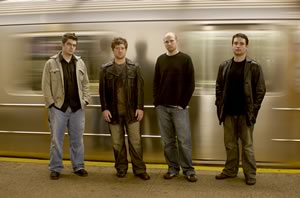
This program included the U.S. premiere of Reich’s new Mallet Quartet, which was partially commissioned by Stanford Lively Arts. Ostensibly, the “quartet” in the title refers to its orchestration for four mallet percussion instruments: two marimbas, plus two vibraphones. Interestingly, though, the piece was also commissioned by several organizations that are affiliated with four percussion quartets: So Percussion, Nexus, Synergy, and the Amadinda Percussion Group, which premiered Mallet Quartet last month at Budapest’s Palace of Arts.
Reich himself participated in a preconcert discussion, and the biggest point about Mallet Quartet to which he drew attention concerns its range. Many marimbas have a range of between four and five octaves, whereas the Quartet is Reich’s first composition exploiting full, five-octave instruments. Since he was unfamiliar with the intricacies of the marimba’s lowest octave, Reich sent So Percussion experimental excerpts during the process of composition, which the ensemble, in turn, recorded and returned to the composer.
Both during intermission and after the concert, however, the aspect of Mallet Quartet that seemed most striking to the audience was not its range, but instead the character of one particular section. The piece unfolds in a ternary form, and in its outer sections, the instruments are paired by type. The two marimbas establish a harmonic and rhythmic foundation that is filled with lively hocket technique, or alternation between the two instruments that creates a continuous, interlocking, and complex composite voice. Over this foundation, the vibraphones play melodically inventive canons. The result is an incessant stream of sound that transfixes, not only through its subtle evolutions, but also through the physical and mental demands it places on the performers. Each member of So Percussion armed himself with four mallets and — playing largely from memory — tirelessly performed.
In the middle section of the work, by contrast, the rhythm slows. Also, the paired instrumentation of the outer parts dissolves into a texture that has sometimes been described, especially in relation to the string quartets of Haydn and Mozart, as “a conversation between four equal partners.” This quiet, contemplative middle section became the talk of the concert. It not only showed a lyrical side of Reich, but also proved that So Percussion can perform with delicate and deliberate nuance, as well as fast and loud virtuosity.
Brilliant Playing? No Problem

On the first half of the program, the 1970s pieces were Clapping Music and Four Organs. Reich himself joined the quartet for their poised beginning with Clapping Music. The group used electronic instruments for Four Organs, a piece that gradually explores constitutive sonorities of a single chord. It exemplifies the idea of deceptive simplicity, because its sustained sounds require counting precise enough to appeal to professional percussionists.
The ensemble closed the concert with Music for Pieces of Wood, followed by the first part of Reich’s well-known Drumming. Reich himself noted that he appreciates the theatricality of So Percussion. The group staged these two pieces by having individual players advance to (and withdraw from) center stage in accordance with the number of players required at any given time. The procession actually incited audience laughter in Music for Pieces of Wood.
Ultimately, So Percussion put a fresh spin on these pieces from the 1970s. Furthermore, by coupling a few of Reich’s older pieces with his new Mallet Quartet, this program showed that even Reich’s oeuvre as a whole can seem deceptively simple. It is easy to characterize all his work in terms of certain techniques, including repetition, canon, and phasing. While such techniques do endure, they also — at least in the hands of So Percussion — always sound exciting and new.

